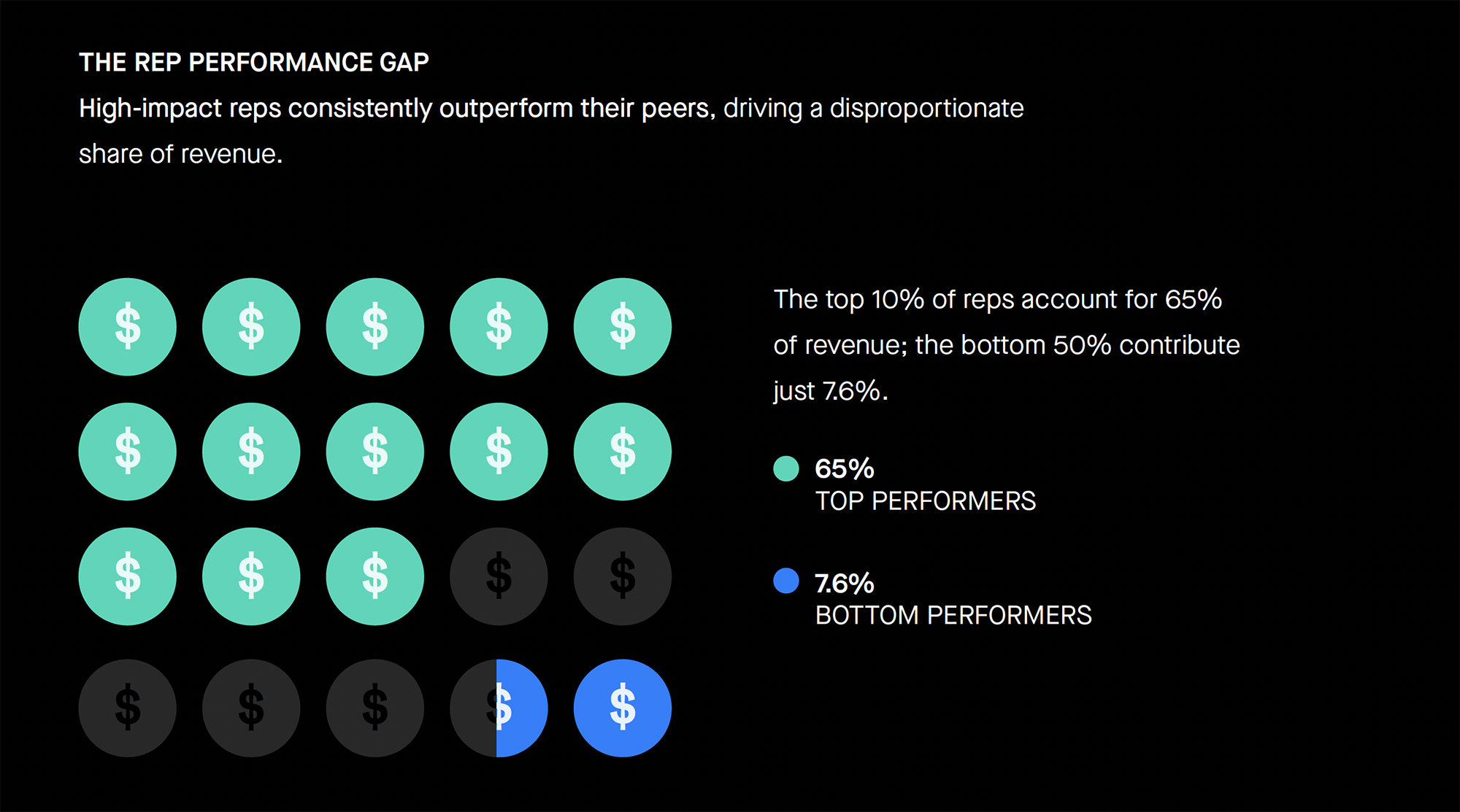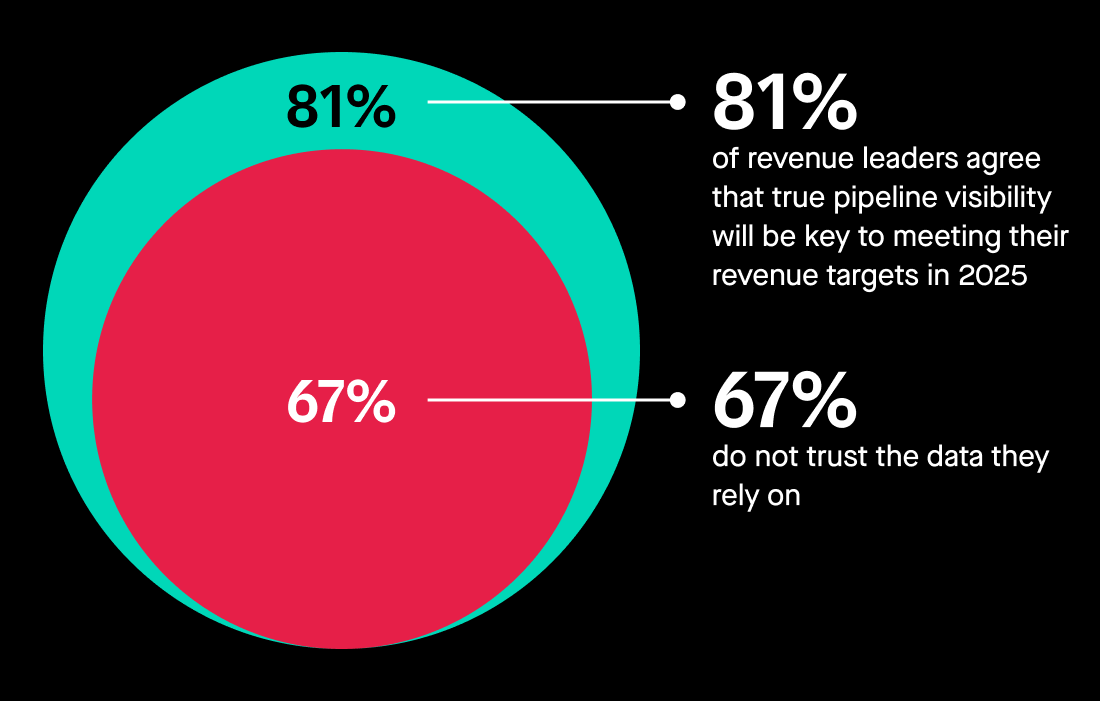Throughout 2025, Clari Labs analyzed millions of revenue opportunities across hundreds of global enterprises. The data tells a clear story: AI adoption, data integrity, and sales productivity are the new battlegrounds. And the gap between the teams who’ve adapted and those who haven’t is growing fast.
The headline is simple: enterprise revenue processes aren’t just changing, they’re literally being reimagined from the ground up. AI stopped being a “nice-to-have” years ago. It’s now the operating system for every go-to-market team serious about winning.
The widening performance and productivity gap
In our study, “The State of Enterprise Revenue 2025: Insights from 10 Million Opportunities,” we found that the top 10% of sellers now drive almost two-thirds of total revenue. The bottom half contribute less than 8%. That’s not necessarily a talent gap. But it most certainly is an execution gap.
The best sellers are running consistent, data-backed motions. As leaders, our job is to identify those winning behaviors and scale them across the entire team. AI is the backbone which helps us accomplish that.
Key findings:
- The top 10% of reps generated 64.6% of total revenue.
- The bottom 50% contributed only 7.6%.
- The top 2% accounted for 37% of all revenue.

Source: “The State of Enterprise Revenue 2025: Insights from 10 Million Opportunities”
What great teams are doing:
- They use data to uncover leading indicators and replicate those behaviors.
- They coach with AI-powered insights to improve performance.
- They design RevOps processes that make excellence repeatable and measurable.
The era of relying on a handful of star performers is over. The companies that will dominate in 2025 and beyond are those that turn elite execution into standard operating procedure, using AI and data to give every seller what they need to be as effective as their A players.
Trust, data, and the human side of AI adoption
Transformation does not fail because of technology. Our research shows that it largely fails because of trust and lack of context. Sales reps hesitate to adopt AI when data quality is questionable or it adds more to their plate vs. making them more efficient. Building a culture of transparency, training, and leadership modeling is key to achieving full-scale adoption.
Clari Labs’ data found that 67% of leaders do not trust their revenue data. When data is unreliable, every downstream forecast, recommendation, and decision falters. CIOs and CROs must co-own the foundation for a unified, reliable data layer.
Action steps:
- Prioritize data cleanliness and cross-system governance.
- Build explainable AI models where sellers can see why recommendations are made.
- Conduct pilot programs to demonstrate early “proof wins” and foster confidence.
- Position AI as mission-critical through visible executive usage.

Revenue expansion, retention, and cadence mastery
While many teams chase new logos, the real acceleration is happening in expansion and retention. Clari Labs found that expansion deals close faster and deliver higher ROI with lower risk. The modern revenue leaders must elevate customer growth and operational rhythm as top priorities.
Expansion and retention as the new growth engine
Expansion deals now close in about 172 days compared to 210 for new logos. Larger expansion deals only take marginally longer, proving that revenue expansion vs. new logo growth is not a zero-sum game but a compounding strategy.
How winning teams operate:
- Map expansion paths with AI signals and growth scoring.
- Identify churn risk early through predictive modeling and action on it via AI recommendations
- Align customer success, sales, and marketing around expansion orchestration.
By embedding these motions into a playbook for GTM teams leaders turn retention and growth into continuous, predictable engines.
Revenue Cadences as the operating system for consistency
Structured cadences create rhythm and accountability across every role. Sales reps and leaders are inundated with information which oftentimes leads to overload. Teams running AI-augmented cadences see 54% fewer handoff issues and 15% higher win rates.
Cadence examples:
- Weekly pipeline reviews and quarterly forecast calls.
- Automated alerts, renewal workflows, and account check-ins.
- Intelligent routing and escalation triggers built into cadence logic.
This level of operational discipline transforms chaos into predictable revenue growth.
From silos to alignment: Fixing the marketing-to-sales handoff
Clari Labs found that broken handoffs between marketing and sales cost companies 10–30% of pipeline potential. The biggest problems come from unclear MQL definitions, missing SLAs, and disconnected systems.
How to fix it:
- Set clear MQL and SQL standards.
- Use shared dashboards and AI-powered summaries of the buyer journey.
- Automate routing so every qualified lead reaches a rep with full context.
Alignment isn’t optional anymore. It’s the difference between pipeline that grows and pipeline that leaks.
When handoffs are automated, every qualified lead reaches a rep in context, eliminating one of the biggest sources of revenue leak.
The CIO–CRO Pact: Building the foundation for AI at scale
Long-term revenue transformation requires partnership at the top. CIOs and CROs must jointly define governance, integration, and AI platform evaluation standards.
Joint ownership of data and governance
The CIO owns the architecture; the CRO owns the workflow. Together, they can ensure AI delivers both control and speed.
Best practices:
- Establish a shared AI council for policy and performance tracking.
- Build a unified revenue data model.
- Evaluate platforms for scalability, explainability, and ROI accountability.
When these leaders move in lockstep, they lay the foundation for AI-driven sales productivity.
The Road Ahead: From point tools to full AI orchestration
The next frontier isn’t deploying more tools, it’s orchestrating them to connect systems, data, and workflows into a cohesive, self-improving loop. Every deal, call, and customer interaction becomes training data for the next action.
What full orchestration looks like:
- AI agents managing routing, prioritization, and coverage modeling.
- Multi-step workflows triggered automatically across teams.
- Closed-loop learning where AI refines playbooks with every cycle.
Enterprises that achieve this transition will finally unlock scalable behavior replication, faster forecasting, and sustained predictable revenue growth with AI-powered revenue orchestration.
Discover how to turn AI into a growth multiplier. Download 6 Strategies for a Stronger Revenue Culture


